Collage Workshop – Botanicals with Sally Hunter
21st October 2025



Sally Hunter is a Member of the Society and was welcomed back for this collage workshop focusing on flowers or plants. Sally has recently been exploring these subjects in her own collages and showed us a selection of work. Members had been asked to bring their chosen images of flowers or plants and Sally had brought along a flower arrangement and a striking anthurium plant with bright red waxy flowers in case we needed inspiration.


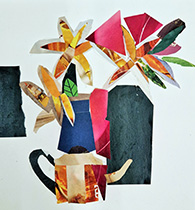
Sally encouraged us to work boldly and to select a colour palette of complimentary or contrasting colours. She had kindly brought along magazines to share and work quickly began with sketches and laying down shapes before committing to sticking them onto the paper or card.
Sally gave tips and advice as the work progressed. It was great to see the different approaches – some began by creating a background, others used the blank paper as the background and quickly added their flowers and leaves.
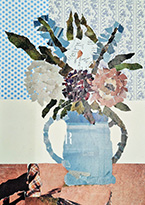
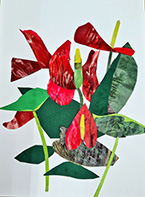


This was great fun. Rather messy with lots of paper tearing. Some preferred to use scissors to give a crisp edge to the work. Some had already prepared painted or printed backgrounds for this project. There are no rules with collage. It simply grows as decisions are made to put this colour there, that shape to one side, all very personal choices.
There was a huge variety in the final pieces of work. Some were soft and muted, others bold with strong colours. Sally was warmly thanked for leading this workshop. Everyone enjoyed it and the display of images below shows great promise for any future works.




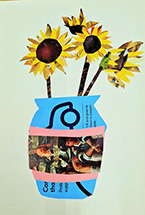

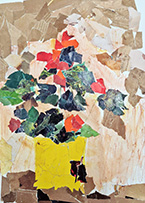

Workshop – Self Portraits
14th October 2025
This was an untutored session and Members had been asked to bring a mirror, a photo or perhaps an image on a tablet or phone in order to work on a self-portrait. This is a challenging exercise.
If working with a mirror, the slightest change in position gives an entirely different view. It is important to try to relax and to almost forget that one is drawing oneself. Members worked in a variety of mediums – charcoal, pastel, pencil, paint and, in one instance, collage.
As the evening progressed it was fun to take a stroll and see how others were doing. There was an opportunity to sketch others while they were working. The variety of approaches and techniques was remarkable and the images were easily identifiable. It was a fun evening and, as can be seen from the impressive results, a very good exercise in observation.
Paper Craft
Create a Poppy Workshop with Nicola Dobrowolski
30th September 2025
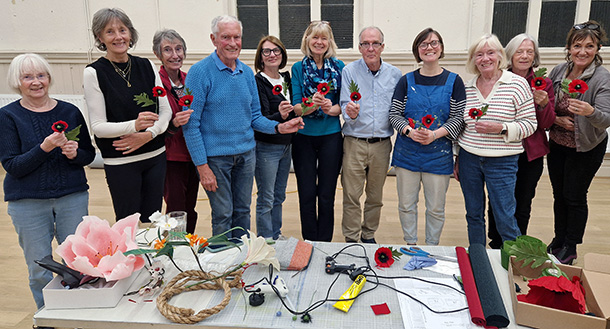
HAS member and master paper crafter Nicola Dobrowolski led this practical workshop in paper crafting. Nicola works on real life scale and larger than life florals for big events and installations, but also has a very varied practice in 3D paper sculpture and 2.5 dimensional paper dioramas. Nicola represented the UK as Master Artisan of Paper Sculpture at the Michelangelo Foundation, and has exhibited and demonstrated in Venice at the HomoFaber biennale. This workshop immediately follows Nicola's installation of hundreds of XL florals at the Four Seasons Hotel London.
All materials were kindly supplied by Nicola - Italian crepe paper in two weights/red, black and green, wire and wax tape. Members had been asked to bring hot glue guns (which were shared), a mat to rest the glue gun and small sharp scissors.


Nicola began by demonstrating the first few stages of the process with these instructions:
- Take wire and, using some soft paper, wind around the top. Bend the wire to secure and continue to mould the paper into a ball shape. Secure end with glue.
- Using the wax tape, cover the ball by wrapping around a few times and then wrapping the tape around the length of wire.
- Double a long piece of black thread, hook around the base of the ball, twist and bring over the top, secure and twist again and repeat 3 more times with equal spacing to form the pistil of the flower.
- Cut a strip of black crepe into fine strands for ¾ of its width, feather the fronds into random directions and wrap and glue it around the base of the pistil to form the stamens of the flower.
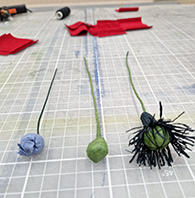
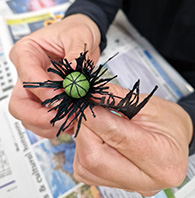

Everyone got going on their own flower at this stage. It was busy and Nicola spent time helping out and explaining how to get the best results. The next stages were undertaken with advice as things progressed:
- Cut 4 petals from red crepe – squares with rounded edges on one side. Stretch the centre of the paper, gather at base then glue two opposite each closely around the black core followed by the remaining petals to form the flower. Stretch the paper to spread the petals out. With small piece of green paper cut into two rounded shapes, disguise the base where the red petals meet the wire.
- Cut a square of green crepe paper diagonally and glue this onto a wire with the “veining” of the paper pointing upwards, one piece on top of the other to hide the wire. Trim into leaf shape with scissors.
- Complete by binding the leaf stem in wax tape and then binding the leaf to the flower stem.

And they were done. Everyone had created a poppy. Some larger than others but all looking gorgeous and very professional.
This was a fun evening. The hot glue guns were a challenge. If anyone can get hold of the ingredients for poppies the instructions above should help. The same principle applies to other flowers so the potential is endless. Nicola was full of encouragement as Members tackled this unusual craft project and was thanked for her help and enthusiasm in making this a very enjoyable session.
Visit to Hatfield House
22nd September 2025
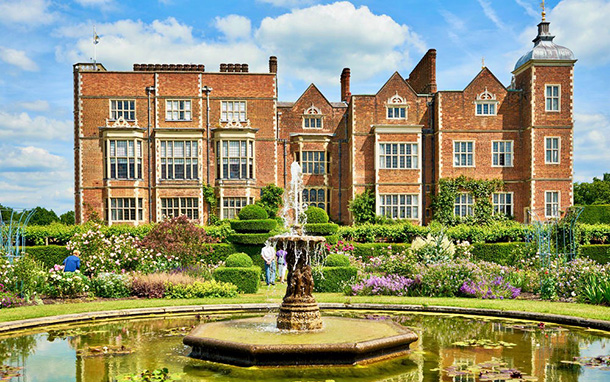
In September Hertford Art Society’s President, Lord Salisbury, kindly issued an invitation to the Society for a group visit to Hatfield House. 28 of us gathered at the House on the morning of Monday 22nd, to be met by Lord and Lady Salisbury, and chief guide, Dermot. Members were divided into two groups, led by Lord Salisbury and Dermot. Half way through the 2-hour visit we changed guides, both of whom were quite brilliant.
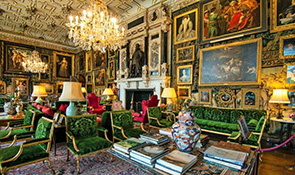
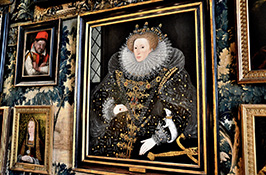
We were treated not just to the many rooms and galleries open to the public, but also to 4 of Lord Salisbury’s private rooms. All rooms, galleries, and halls are bursting with pictures and mementoes of centuries of the public and private lives of the Cecil family, starting with the 1st Earl of Salisbury, William Cecil, Lord Burghley who was a close adviser and confidant to Elizabeth 1st. The portraits are a pictorial history of the Kings, Queens and aristocracy of this country, from the 16th Century to the present.

Perhaps the most impressive image is ‘The Rainbow Portrait’ - Queens Elizabeth 1st clutching a rainbow hammering home the message ‘no rainbow without the sun’ – i.e. after storm comes Elizabeth, a bringer of peace. She wears a splendid gown adorned with symbols, most notably several eyes and ears: a not very subtle political statement of the surveillance of Tudor society by Elizabeth and her advisors, notably Lord Cecil, this county’s first spymaster. Elsewhere Elizabeth’s hapless rival, Mary Queen of Scots is portrayed.
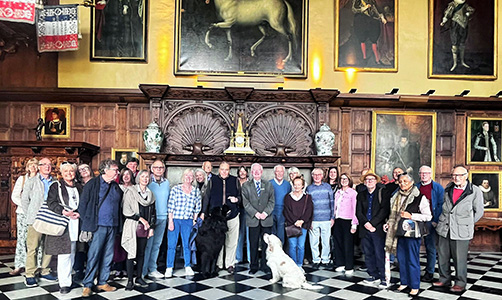
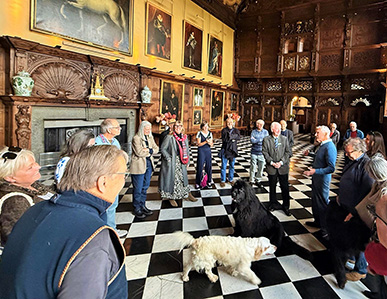

There are many more friendly portraits including a splendid life-sizes portrait of the present Lord Salisbury casually hanging at the top of a flight of stairs.
The visit was a wonderful opportunity to savour through pictures the impact of the Cecils on English, later British, life throughout the last 500 years. A thoroughly enjoyable two hours courtesy of our President, Lord Salisbury.
Quick Sketches
9th September 2025

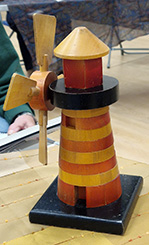

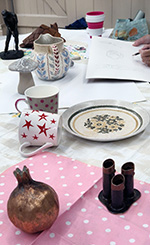

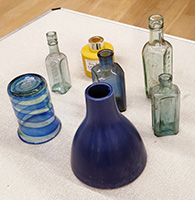

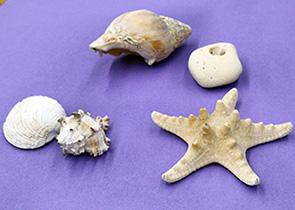

This was an untutored session and Members were invited to bring an interesting object to sketch or paint. The display was certainly interesting - items included an African statue, a windmill, a striking blue cat, a leaping metal dolphin, colourful bottles and, from the natural world, a selection of seashells, an intriguing twisted branch and a sheep’s skull. Some colourful fabrics gave an added twist.
The aim of the session was to encourage quick, bold sketches and the timer was set to 10 minutes, after which a change in position brought a new challenge. This was a very enjoyable evening and very well attended. Some Members were ambitious enough to use paints and, as can be seen from the images, there were some impressive results. A few used a large format to overlay and blend the various elements very successfully. Some focused on detailed and exact sketches. A great variety of media was in play. It was fun to work quickly and enjoyable, at the end of the session, to see the variety of work produced.

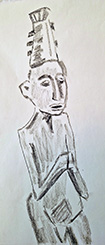
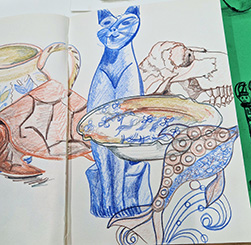
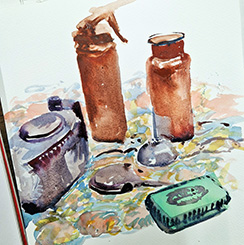
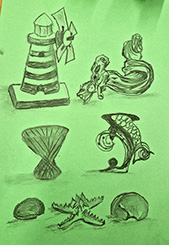
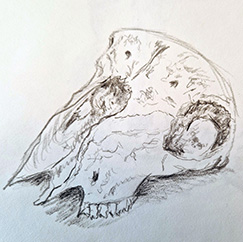

Winter Programme 2025 - 2026
The Winter Programme 2025-2026 begins on Tuesday 2nd September 2025.
These sessions are on Tuesday evenings from 7.30pm to 9.30pm at Cowbridge Hall, Cowbridge, Hertford SG14 1PG. Approximately half the evenings in the Winter Programme are for Members’ Workshops, some tutor led, some just as a group practice. There may be a small charge for workshop materials. This season includes still life arrangements, life models, printing and paper craft. The remaining evenings are taken up with talks, critiques of paintings brought along by Members or demonstrations from a professional artist.
Visitors are very welcome to come along to talks, demonstrations and critiques of Members’ work (Charge £5).
Saturday Life Workshops will recommence on 27th September 2025 and non-Members are welcome. Charges £20 per session for Members; £25 for visitors. See details on Life Workshops below.
The Members’ Show will be held from Friday 31st October to Sunday 2nd November 2025 and Members can contribute up to 4 paintings or other artworks to this Show.
- Winter Programme 2025 - 2026 (pdf) - click here for more details
Saturday Life Workshops
WHY LIFE DRAWING AND PAINTING? – Some may say it is old fashioned, but practising Life Drawing enhances observation and accuracy. Interpreting the shape of the human body trains the artist to see almost every curve line and subtle undulation found in nature. The satisfaction of producing an acceptable image can be quite intense. It does not happen immediately and demands a great deal of practice to achieve.
Hertford Art Society runs Life Workshops in Cowbridge Halls, Hertford, SG14 1PG on the last Saturday of 9 months during the year. An exception is the October session which is sometimes changed when it coincides with the Members’ Show. The July 2026 session also takes place on the third Saturday in the month. Although these are primarily run for Members we welcome enthusiastic visitors at £25.00 per session, this includes coffee, tea and biscuits, available all day. The sessions are untutored and last from 10.00am – 4.00pm with a break for lunch. We work in in all mediums including prep work for sculpture. Bring whatever medium and equipment you require with you. The photographs below illustrate the exciting variety of work produced by the artists.
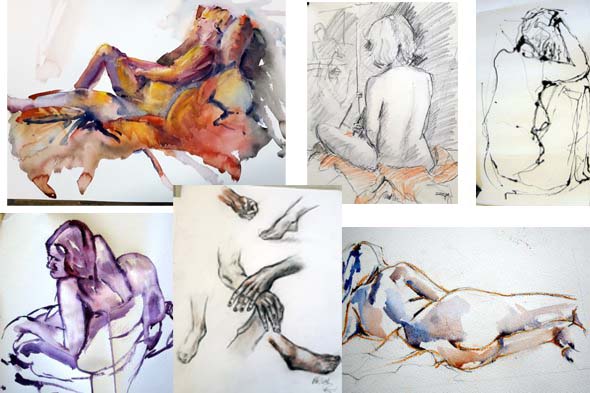
There are many different approaches to life drawing which become very obvious during the sessions. We are a very enthusiastic group of artists and in a relaxed atmosphere we learn from each other different skills and methods of working, as well as experimenting with different mediums etc. We do not have a set programme of poses, but usually include short poses and longer poses for artists who wish to produce a more finished piece of work. So why not join us if you haven’t already?
Workshops take place on the last Saturday of the month (except for October) for nine months of the year. They do not take place in April, August and December due to the annual Open Exhibition and holiday periods.
Life Models Workshops within HAS Winter Programme for 2025 - 2026 - 10am - 4pm at Cowbridge Halls, Hertford, SG14 1PG
- Saturday - 27th September 2025
- Saturday – 25th October 2025
- Saturday - 29th November 2025
- Saturday – 31st January 2026
- Saturday - 28th February 2026
- Saturday - 28th March 2026
- Saturday - 30th May 2026
- Saturday - 27th June 2026
- Saturday – 18th July 2026
If you are interested please contact [email protected] for further details.
Cars at the Castle
1st June 2025

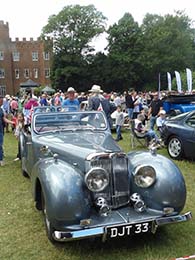

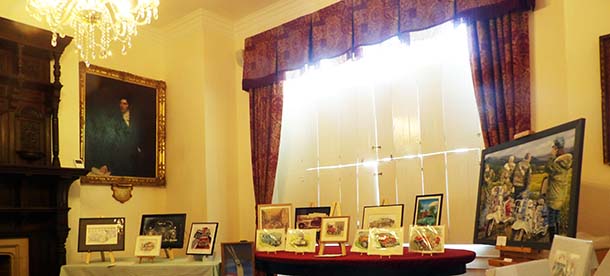
Cars at the Castle is one of the largest FREE vehicle shows in Hertfordshire, with an exhibition of over 60 modern and vintage cars and motorcycles, set within the picturesque grounds of Hertford Castle.
This highly popular, family friendly annual event took place on the afternoon of Sunday 1st June 2025 with live music, food and drink stalls and the Castle open for the public to explore - there was something for everyone.
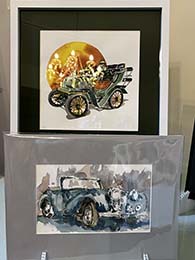

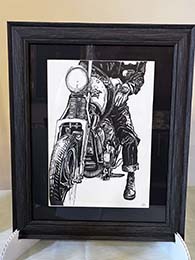
Visitors were able to view a car and cycle themed art exhibition hosted by Hertford Art Society, located in the Mayor’s Parlour, inside the Castle. There was also a display of work and greetings cards for sale in the Society’s Gazebo situated in the Castle grounds. Many thanks to the following Members for contributing work for these displays: Geoff Bennett, Trevor Chamberlain, Debbie Elsden, Gary James, Mike Lawrence, Persis Limbuwala, Angela Roberts, D'Arcy Sallion, Tom Sim, Sally Steele, Neringa Sustensiene, Diane Warburton and Alison Wright. It was a varied and colourful collection of work on this most interesting theme.

Councillor Vicky Smith commented “This is one of Hertford Town Council’s most popular events, with lots for all the family to enjoy.”
Presentation of Mayoral portraits at Hertford Castle
30th April 2025
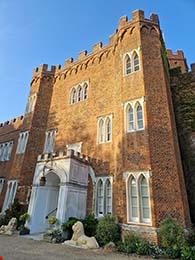
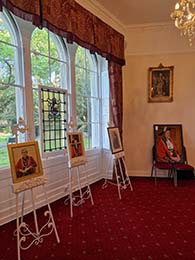
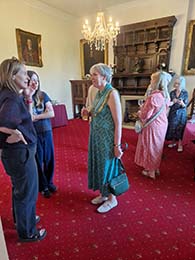
Dating from the mid-15th Century, Hertford Castle hosts many events throughout the year and houses the offices of the Town Council. It is a beautiful building set in historic grounds.
Each Autumn, Hertford’s Mayor is invited to comes along to a Tuesday evening session at Cowbridge Halls and sit for their portrait. Members of Hertford Art Society enjoy painting and drawing the current Mayor in full regalia and many colourful images result from this enjoyable annual event.
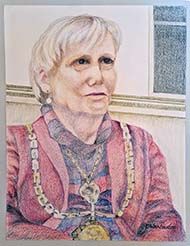
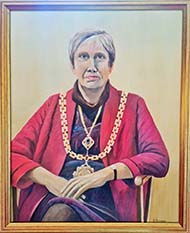
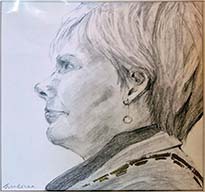
Images of Rachel Carter - Mayor 2024
Left: by Daine Warburton;
Middle: by Joe Rowson;
Right:
by Jill Rolfe
A group of Members were delighted to be invited by the current Mayor, Rachel Carter, to present paintings and drawings of herself and the previous Mayor, Vicky Smith, resulting from the two portrait workshops in 2023 and 2024. As these sessions are only 2 hours long, many of the artists had completed their portraits later, using sketches and photographs taken on the night. These paintings and drawings were displayed in the lovely rooms within the castle and the artists were offered drinks and nibbles as the current and previous Mayors, Rachel Carter and Vicky Smith, admired the work and chatted to the Members who had been able to bring their work along.
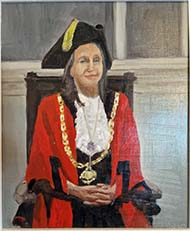
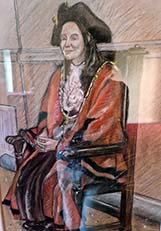
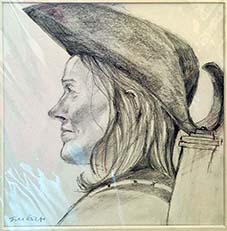
Images of Vicky Smith - Mayor 2023
Left: by Angela Roberts;
Middle: by Derek Carey;
Right:
by Jill Rolfe
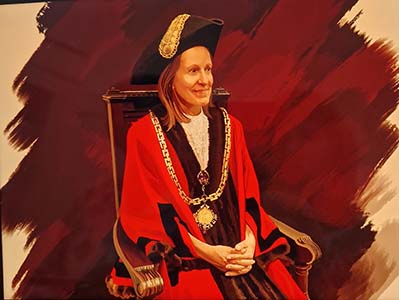
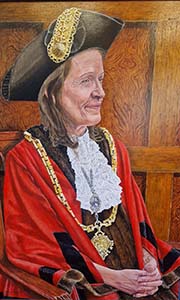
Left: by Sally Steele;
Right:
by Mike Lawrence


Left: by Joe Rowson;
Right:
by Kay Frid
This was a very enjoyable evening. Our hosts were warmly thanked for arranging such a pleasant get together. Mayor Rachel Carter is just coming to the end of her term. We will look forward to painting the next Mayor as this has become a traditional part of the Autumn programme.
Elijah
Paintings to illustrate Hertford Choral Society’s Easter Concert
29th March 2025
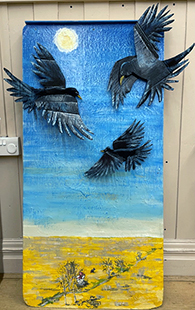
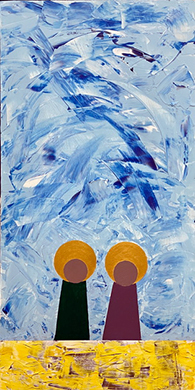
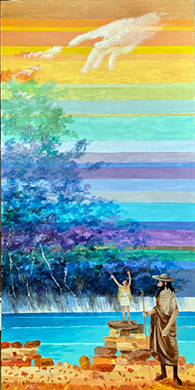
Left: By Cherith's brook - Geoff Bennett
Middle: That the son may live - Christie Gilfeather
Right:
Cloud arising - John Jarratt
Each year embers of Hertford Art Society are invited to illustrate Hertford Choral Society’s Easter concert, performed in All Saints Church in Hertford. This year’s concert is Mendelssohn’s oratorio ‘Elijah’ which will take place on Saturday 29th March.
This vividly dramatic oratorio draws its text from the Bible and tells the story of one of the fiercest prophets of the Old Testament. It opens with the pronouncement from Elijah that due to the people’s unfaithfulness, there will be a long drought. The following scenes were illustrated by the artists named in brackets.
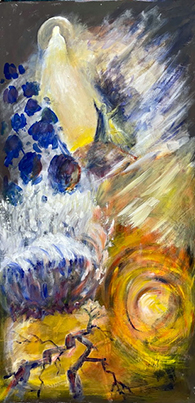
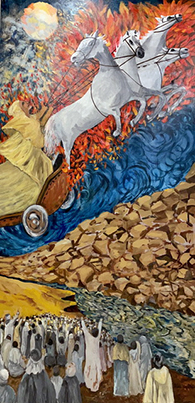
Left: After the earthquake - Ray Ward
Right:
By whirlwind to Heaven 1 - Diane Warburton
An Angel advises Elijah to go into the desert and hide by Cherith’s brook where he will drink its waters and be fed by the ravens (Geoff Bennett)
A Widow comes to Elijah (Christie Gilfeather) and asks for his help for her son who is so sick that there is no breath left in him! Elijah prays that the spirit of this child return, that he again may live.
Elijah asks the Lord to regard the distress of His people and to open the heavens and send them relief. A Child sees a little cloud arising now from the waters like a man’s hand. (John Jarratt)


Left: By whirlwind to Heaven 2 - Izabella Taylor
Right: Ascending into Heaven - Alison Wright
A mighty wind breaks the rocks of the mountains. The sea is in upheaval, and the earth shaken. After the earthquake comes a fire. (Ray Ward)
The Lord takes Elijah away to heaven in a fiery chariot with fiery horses, he goes by a whirlwind to heaven. (Diane Warburton; Izabella Taylor)
Elisha witnesses Elijah ascend into Heaven (Alison Wilkinson)
With grateful thanks to all the artists who contributed to this colourful and dramatic display.
Spring Flowers Still Life Untutored Workshop
18th March 2025
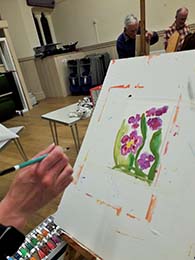
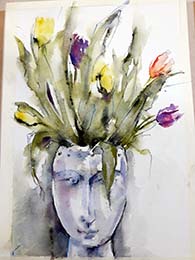
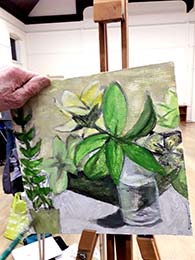
Members contributed a variety of lovely spring flowers to this untutored workshop including daffodils, tulips and hellebores. There were also interesting pots and vases to draw or paint and several different groupings and layouts. Some artists produced a range of sketches while others concentrated on creating one image.
This was a very enjoyable evening and resulted in some interesting paintings and drawings. Some were bold and colourful, others delicate and detailed.

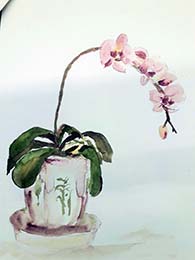
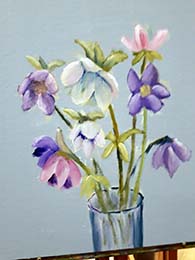
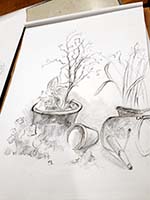
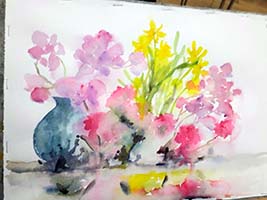
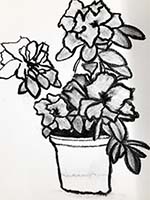
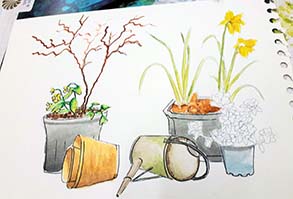
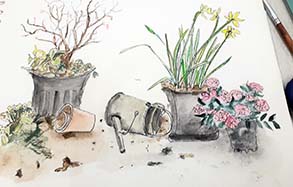
Printing from a Tetra Pak
Workshop with Jude O‘Sullivan
11th March 2025
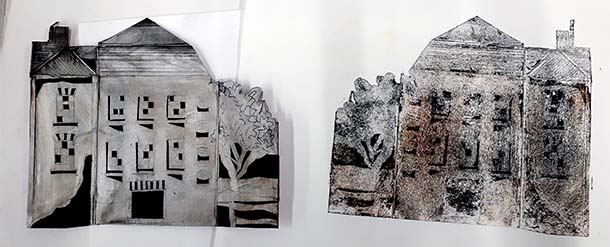
We were delighted to welcome back Jude O’Sullivan for this Workshop – a new experience for all of us. Jude started her career as a graphic designer, then progressed to teaching graphics and printmaking in the Further Education sector. She currently teaches all forms of printmaking at Courtyard Arts in Hertford.
Tetra Pak is a branded type of packaging for liquids, originating in Sweden in the mid-20th Century, recyclable and now commonplace. The interior face of the coated paper carton can be used for a distinctive printing process which does require a silver metal coating inside (not always the case).
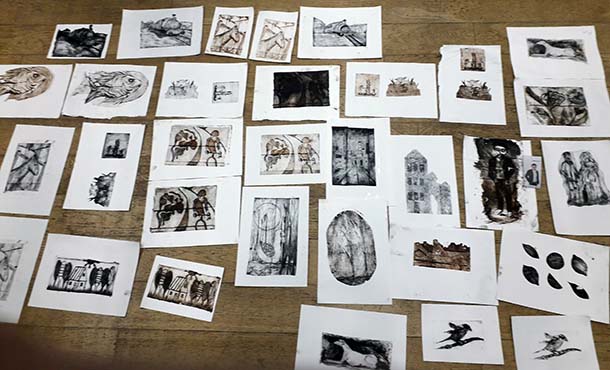
We were asked to bring a protective cover for the tables (newspaper or plastic), a sharp knife or scalpel, other sharp implements to create lines/impressions, tissues and a soft pencil. If possible also a silver coated Tetra Pak, cut and opened out. A supply of these was kindly provide by Jude, together with paper, printing ink and engraving tools.
Jude explained the process and showed us a range of her prints created by shaping and cutting layers from the Tetra Pak, using sharp implements to make linear or random marks in the surface. Using a scalpel the top layer can be lifted off as required. These areas form the darkest tones of the eventual print. On printing, the ink is worked into the recesses and lines of the plate. This is termed Intaglio printing – to incise.
This was a very well attended Workshop and Members had brought along sketches and ideas. Work began on creating printing plates. Some members cut and shaped the outline of images – a fish and a sheep came into being. Some used a rectangular shape for their design. Jude gave tips and advice on getting the best result from this process, always bearing in mind that the image will be reversed.
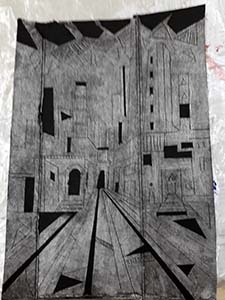

Left:
Printing plate; Right: Resulting Print.
Once completed the plates needed to have ink applied. This was done using small pieces of card and pressure to spread the oil-based ink into all the crevices of the design. (Jude recommends only using oil based inks for this process.) Then most of the ink needed to be removed. Jude had supplied a piece of course scrim and some cotton rag. It was tricky to remove just enough ink to achieve a good result in the final print - a judgement call. Dabbing seemed to work best and the remaining ink could be brushed for directional lines as required.
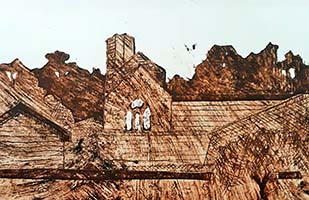
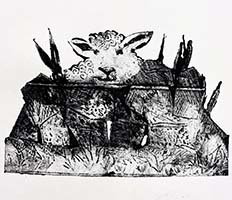
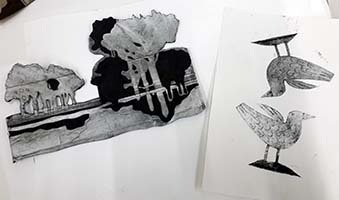
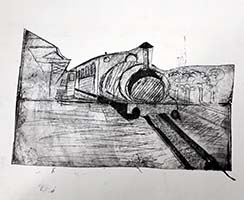
The paper was soaked briefly – this allows the paper to “sink” into the printing plate and to pick up small details. Jude had brought along two small, hand-turned presses. Scrap newspaper was used as a base to soak excess water, the plate was placed on this, damp white paper on top, more newspaper and then a thick piece of felt. This was rolled through the press for the first print and then subsequent prints were taken, with softer results. Jude feels that the best results are accomplished with a press (and advises that small presses can sometimes be found, secondhand) but it may be worth experimenting with rollers or pressure from spoons to see if worthwhile results can be achieved.
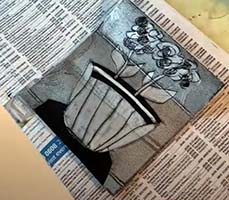
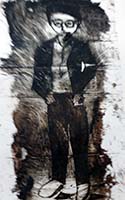
The designs chosen were wide-ranging and the resulting prints were exciting and really varied. This was an interesting and challenging workshop. Much was accomplished in 2 hours and Members enjoyed working with this novel material in order to achieve original prints. The process is quite different to lino printing (which many had done in the past) as the dark areas are excised into the plate and the light areas remain.
Jude was warmly thanked for this enjoyable Tetra Pak printing Workshop, for providing so much material and equipment and for her unfailing advice and enthusiasm.
Watercolour Demonstration by David Hyde
28th January 2025

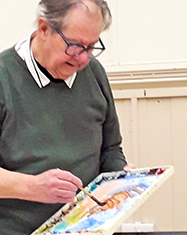
Painting by David Hyde.
David Hyde is a self-taught artist who has exhibited widely, demonstrated at national art shows, teaches watercolour painting and has a wide range of tutorials available on YouTube. This recent venture is to give his artwork some 'purpose' and to share his technique with like-minded people who are already painting or are just starting out. His landscapes are bold and traditional, his animal and bird paintings alive with colour.
This watercolour demonstration had David working with his board upright on the easel – good for the audience, tricky for the artist. Normally he would work on a shallow slant. He had chosen a photo of Houghton Mill, a National Trust site in St. Ives, Cambridgeshire, and had lightly sketched an outline on 140g NOT* rag paper. He used Bockingford watercolour paper which is his normal choice for demonstrations, Arches being his preference for commissions etc.
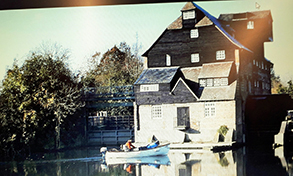
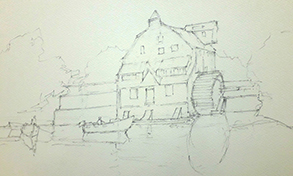
Houghton Mill.
David recommends taking photos on bright sunny days in order to get the maximum light and contrast. “Paint the light, not the object” is his guidance and to use the photo as reference only, noting where the lights and darks should be, simplifying the image and seeking to portray the “atmosphere” of the scene. He advised moving things around if they don’t fit and had adjusted the positions of the boats on his sketch. He used a fairly limited palette of Artist quality paints, a mixture of Windsor and Newton and Daniel Smith colours. He stressed that the tones are more important than the colours. His brushes were synthetics - a mixture of rounds and flats, some from Spanish brand Escona. He uses a large palette with the paints squeezed into pans around the edges. This allows space for multiple, generous colour mixtures.
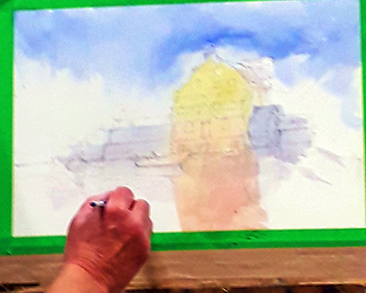
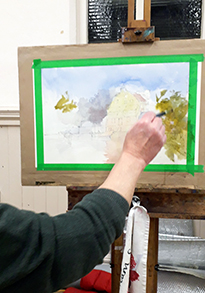
The demonstration began with David wetting the paper and applying various light washes to the sky, the mill, background trees and river. He used Cobalt Blue and Lavender by Danial Smith which is a soft blue/grey for the sky, Aureolin Yellow and a touch of Crimson for the mill and a mix of everything for the trees. Once this had dried a little, David began to add darker tones, using Ultramarine Blue and Burnt Sienna, taking advantage of the damp paper to blend the colours. A colour called Aussie Gold by Daniel Smith made a very strong ochre and interesting green mixtures. He used a variety of brushes, flat ones for defining the crisp edges of the mill, some dry brush for the tops of the trees, a Princeton Velvet Touch brush for detailing and a goat hair hake brush, a very slim flat brush for broad strokes. He worked around the whole painting using his imagination to create interesting colour and tonal contrasts, basically ignoring the original photo. He let the brush “dance and play” as he held it loosely to give life to the trees and water surface. The wooden planks of mill were painted in a strong dark brown, in several coats and these darks were used in the foreground trees and the water to bring the image together. As the painting dried further darker darks were applied to branches, shadows and reflections.
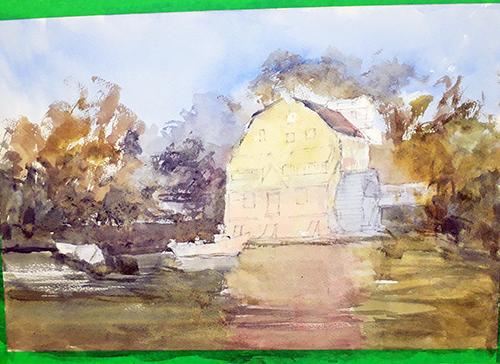
Final touches were applied with a sword liner brush which holds a good quantity of paint and allows fine, crisp marks for branches etc. He wetted some areas to lift paint off, splattered some paint here and there and added some white gouache to mixtures to create highlights and break up some of the dark areas. Using orange paint he added figures on the boat and defined it with bright white fenders.
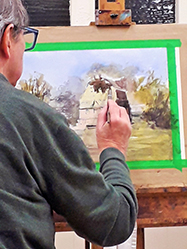
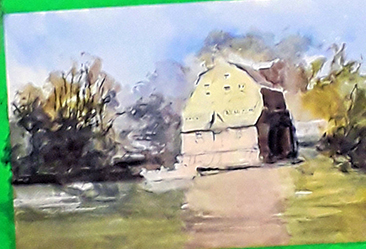
This was a very enjoyable demonstration. In less than two hours David had produced a dramatic painting. There was great focus on using light against dark tones. David commented throughout and was pleased to answer questions and discuss elements of his technique. The details of paints and brushes were very helpful. He was warmly thanked for such an impressive demonstration.
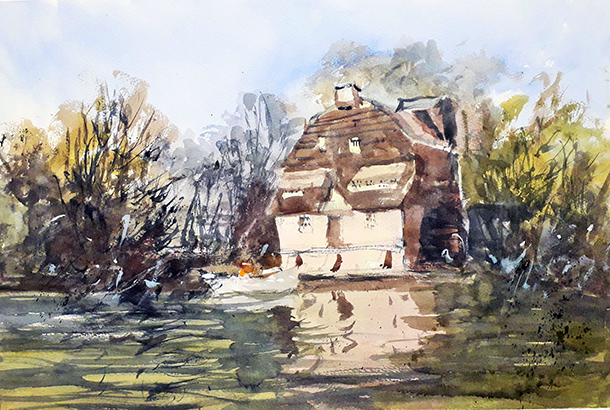
*A note on watercolour papers -
- Hot Pressed paper tends to be favoured by artists that like to work delicately and with a lot of subtle detail, for example botanical artists. It is the least textured surface, and is completely smooth as it is pressed between 2 hot metal rollers.
- Not and Cold Pressed paper amount to the same textured surface – this is the name given to paper with has a slight tooth to it. It is the most popular surface for watercolour painters as it allows for a little texture in your work, as the paint will sink a little into the dimples on the surface of the paper, but it will also be sympathetic to some detailed work. It is made by pressing through the cold metal rollers. NOT = Not hot pressed.)
- Rough paper comes in various qualities and can be used where a textured surface is required.
Self Portrait Workshop with Susan James Dean
21st January 2025
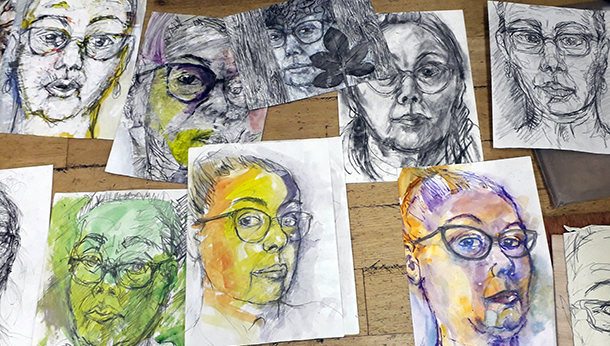
Susan James Dean has a degree in Fine Art and a background in art education. She continues to be a visiting artist in schools, delivering drawing and painting workshops. Susan has been a life drawing tutor for many years and for this workshop demonstrates her approach using A3 cartridge paper, graphite, charcoal and rubbers, as well as a mirror! Members were invited to bring any materials they are comfortable with, including colour (soft pastels or crayons). Susan brought supplies of materials to share as needed as well as a huge collection of self-portraits illustrating her bold and varied approach.
Susan begins by describing her background and showing examples of her own work. Her first demonstration is in graphite – using large broken sticks to quickly sketch a large self-portrait. She advised that the lower part of the eye socket represents the approximate half way point of the head and plots the features using this scale. Soft graphite allows for smudging and corrections as the sketch takes shape. She traces, using the mirror, the path of various lines and adds shading, very roughly. The angle of the face must be carefully observed and her advice is to rework and keep correcting, rubbing out highlighted area and enhancing shadows. This results in a lively drawing.

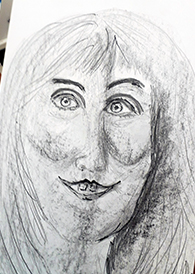

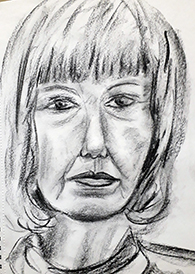
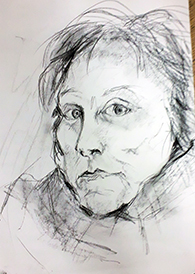
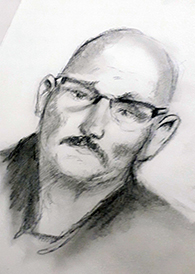
Susan suggested we try using graphite for our first quick sketch. Everyone was keen to get started. Some had brought mirrors, others worked from photos, phones or tablets. These latter items had the benefit of the model not moving! Working around the room, Susan gave tips and advice as portraits started to take shape.
The second demonstration was using charcoal, a much softer material which allows infinite change and manipulation. Work soon began on a second portrait and, as can be seen from the photos, resulted in some excellent images, all giving at least a nod to the features of the artist and some demonstrating a brilliant likeness. Some artists worked in colour but most focused on achieving a likeness in monochrome.
This was a very enjoyable and well attended evening. Susan was warmly thanked for sharing her approach to portraiture with us and for her individual advice and encouragement throughout the session.

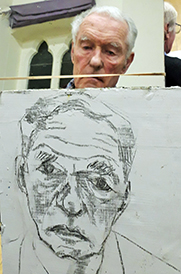
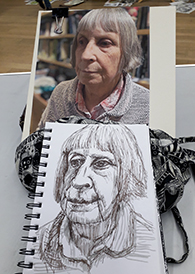
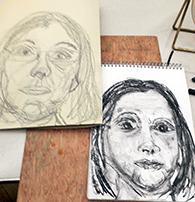

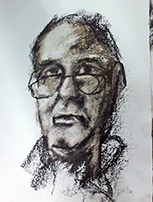

Critique with Mike Todd
3rd December 2024
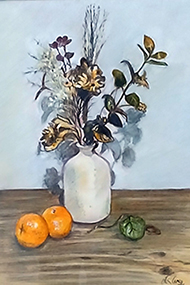
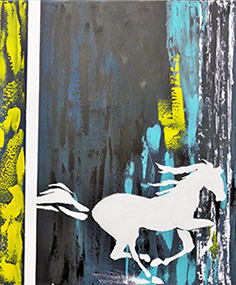
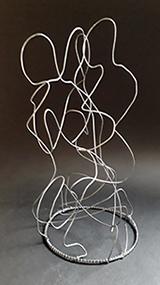
Left to right by Derek Carey, Alona Kushnirenko,
Kathy Burman.
Each month Members are invited to bring one recent artwork for a Critique Evening. This is a traditional element of the Society’s Winter Programme and is normally led by a professional artist or tutor who appraises and comments on the work and gives advice and tips on how it could be improved or enhanced. They may ask the artist what inspired them to paint, draw or sculpt the particular image and how they approached the work. Colour choices are explored, tones evaluated and composition discussed. The presentation of the work is part of this process – the decision of how to crop the image, the choice of mount or frame. Some work is still in progress, hence unframed and suggestions may be made as to framing etc.. Members of the audience are often invited to comment.
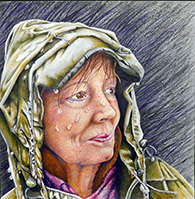
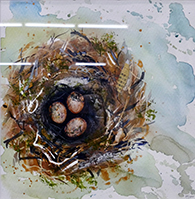
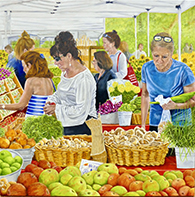
Left to right by Sally Steele, Kater Tyrer, Mike Lawrene.
The Critique on 3rd December was led by Mike Todd, the Head of Art at Richard Hale School, Hertford. Mike is a regular visitor having led past Critiques and acted as a judge in past Exhibitions. He praised the wide range of artwork on view during the evening and gave considered advice on each item. As well as his teaching duties he takes time – every day at 5a.m.! – to sketch and draw for his own pleasure. He had brought along some sketchbooks which showed his diverse interests and influences. He also talked about the talents of his many students.

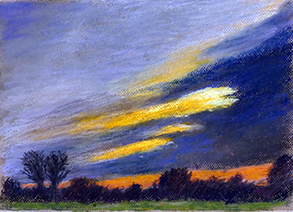
Left to right by Joe Rowson, John Smith.
A few of the Critiques are DIY evenings with Members presenting their own work, talking about the difficulties and pitfalls of bringing the work to a satisfactory conclusion and asking for feedback from fellow Members. Lively discussions often follow.


Left to right by Tony Gibbs, Jill Rolfe.
Although rather daunting, this is a very valuable exercise. It gives Members the opportunity to evaluate their own work and the work of others, to learn more about their colleagues’ techniques and skills and to apply the advice of the professional artist who has been invited to lead the session to their own artwork. New Members are warmly encouraged to take part. This display is of all the artworks brought along for this Critique. It is colourful and varied and illustrates the broad range of artwork undertaken by Members of the Society.

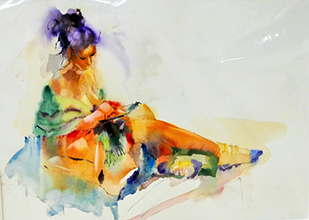
Left to right by Geoff Bennett, Michael Radley.
Mike was warmly thanked for leading this lively evening, for his constructive comments and advice and for sharing his own work with us.
Fantastic beasts
Clay workshop with Abel Kesteven
12th November 2024

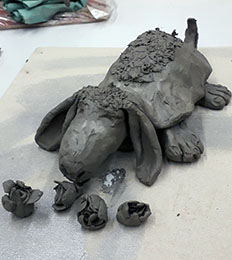
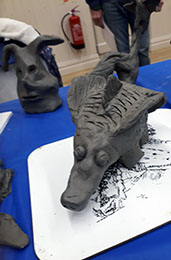
Originally trained as an illustrator, Abel Kesteven is a multi-talented artist who loves to explore new techniques and ideas. He has exhibited widely and over the years has developed a very spontaneous semi-abstract approach to painting, drawing and modelling in clay. We were delighted to welcome him back for this workshop.
He runs drawing, sculpture and monoprint workshops for local art societies and also leads therapeutic art sessions in day centres and care homes in and around his home area of Carshalton, Surrey. Not only does this provide a regular income but is also a source of inspiration, working with adults who have varying degrees of physical and learning difficulty. They have a fearless and unconscious approach to their art which is wonderful to observe and has inspired him to express himself more freely in his own work.
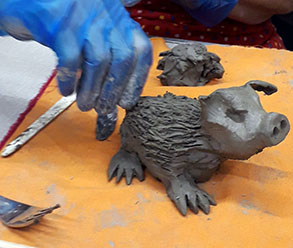

A fearless approach was definitely needed for this workshop as Abel showed us images of imaginary or mythical animals formed from blending two different creatures together. He encouraged us to give our imaginations free reign in designing such a creature – no rules, anything goes.
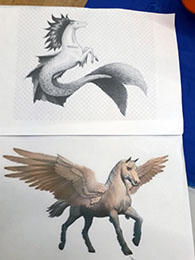


Using air drying clay he demonstrated some basic techniques:
- Modelling a large piece of clay then hollowing out the body cavity from below with a wire tool;
- Forming two balls of clay into cup shapes using the palm of one hand and thumb of the other. These two pinch pots (or thumb pots) are then joined together by scoring and wetting the edges and pushing together. A small coil of clay is then laid on the join and blended in. This hollow body shape forms the basis of the figure. (If it is to be fired a small inconspicuous hole will need to be made.)
- If the animal needs legs to support it then a large coil is rolled out, cut to size and each leg pushed into place with scoring, wetting surfaces and coils applied around the joins.
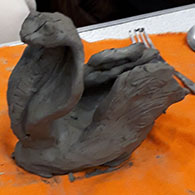
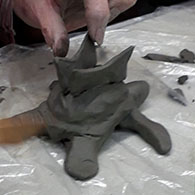
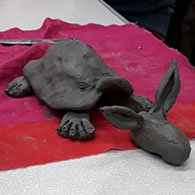
The clay provided will air dry to a fairly strong model which can then be sealed with PVA and painted. If a kiln is available, the model can be fired – once to “biscuit” and then to “stoneware” temperature. This will make the model strong and robust. Glazes could be added.
Many members who had brought photos of animals had a rethink as to how their chosen subject could be modified/enhanced and the work progressed at a very impressive pace. Abel gave recommendations and guidance on how to add and form the clay to get the best outcome and some glorious creatures began to emerge.
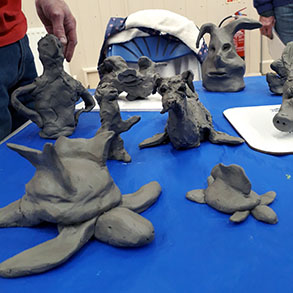
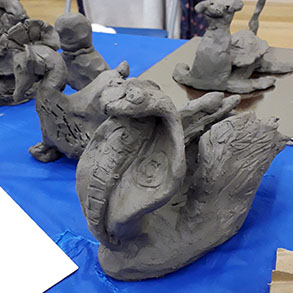

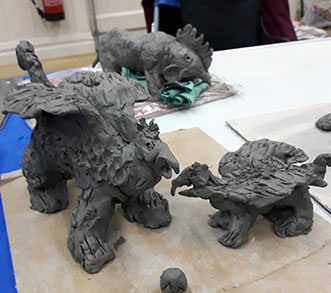
This was a very enjoyable workshop - messy but fun. By the end of the session Members had created a virtual menagerie of Fantastic Beasts – a swan with the head of a cobra, a sheep/turtle, a chicken with dragon’s wings, a dog with a seal’s body, an elf with rabbits ears and a fox with a very stylish coat among many others. They were carefully packed for the trip home.
Abel was warmly thanked for leading this unusual workshop and for giving us the benefit of his advice and expertise. The results were striking, impressive and Fantastic.
Autumn painting and drawing workshop
29th October 2024
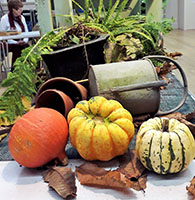
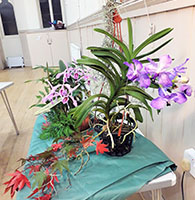
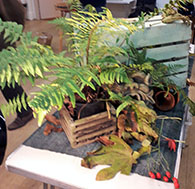
This was an untutored session and Members worked in various mediums, sketching and painting the superb arrangements of plants, watering cans, pumpkins etc. kindly provided by Michael Radley.
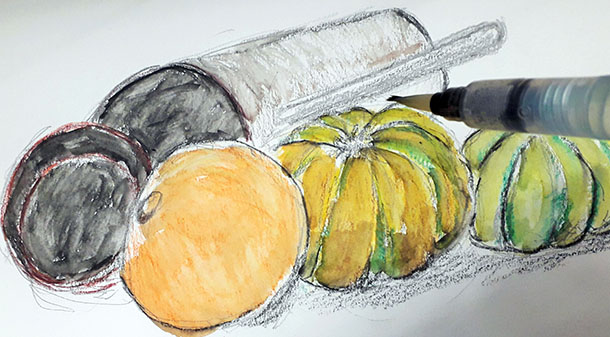

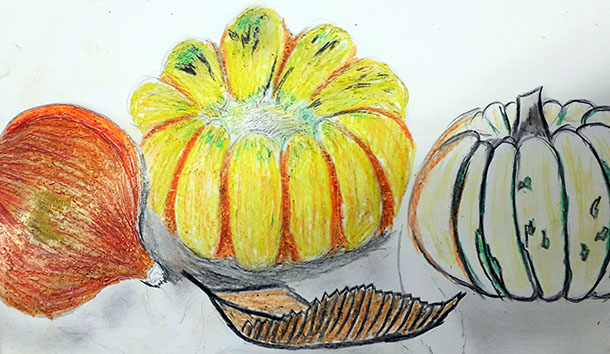

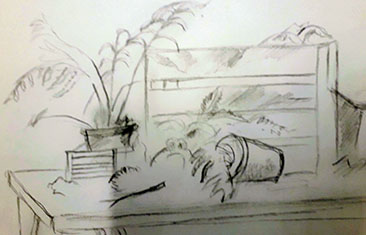
There was something for everyone – from delicate orchids to sturdy pots and watering cans and Members appreciated the challenge of capturing an image in the space of two hours. Some used watercolours, others acrylics or pencil.
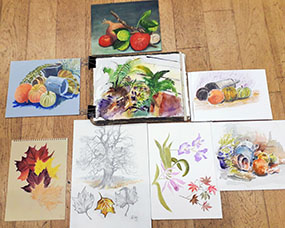
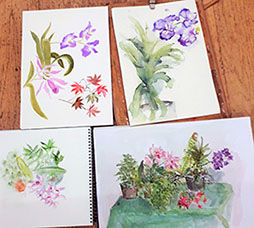
The resulting paintings were lively and colourful. Some had been completed but others could be worked on further or form the basis of future artworks. Michael was warmly thanked for setting up such great displays – this was a very enjoyable evening.
Introduction to Gelli printing
Demonstration by Mitzie Green
8th October 2024

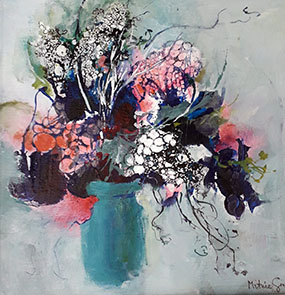
Mitzie Green is a painter and printmaker who enjoys working in a playful and spontaneous manner where unexpected results are allowed to happen. She has exhibited widely and runs regular workshops.
For this demonstration Mitzie is equipped with a Gelli pad (a durable, reusable plate that looks and feels like gelatin), large tubes of acrylic paints (Amsterdam brand, but any will do), small roller, ‘Logan wrap’ parchment paper (easy to use semi-transparent sheets similar to greaseproof paper), stencils, stamps, brushes and water/rags for cleaning up.
Mitzie applies paint directly from the tube to the Gelli pad and rolls it to a smooth layer. She then quickly cleans the roller on a blank sheet of paper before applying a stencil on top of the paint and a piece of parchment paper which she presses and then rolls firmly on top of the stencil to obtain a print. A second “ghost print” is then taken. The plate is then cleaned. The sheet on which the roller has been cleaned builds up a great texture and pattern of its own.

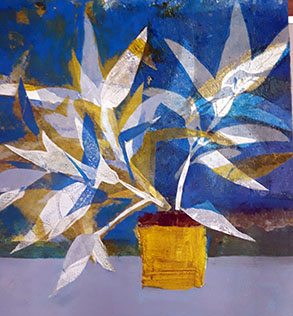
The nature of the Gelli pad allows the paint to creep up onto the paper as it is compressed giving a totally different result to printing from, say, a glass plate. Stencils can be hand-made (using 160g paper) or bought from art stores or online. Mitzie has a huge collection, ranging from delicate to bold, and she uses the prints extensively in her paintings and collage work. She demonstrates using multiple stencils on the same print, several colours together, white paint as a contrast and builds up various examples. A stencil can be used on top of a printed sheet with paint applied with a sponge or brush.

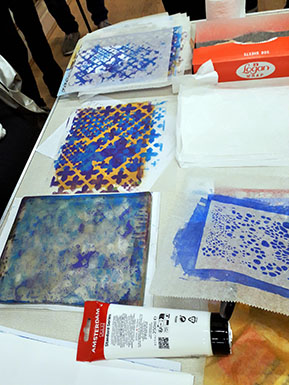

Scraps of lace fabric make good stencils and Mitzie has a stash of “recycled” bits and pieces (textured cardboard, handmade rollers with string applied) as well as large stamps to give variety. With a lid from a bottle she impresses the Gelli pad directly in order to lift paint off before taking a print. A silicon scraper has the same effect. Cut out shapes can also be set onto the pad. Frequent and swift cleaning is essential for both the pad and roller as acrylic paint can “set” if left. Baby wipes are recommended.
By this stage there is a vast variety of printed sheets and often unexpected results from combining different stencils or approaches. “Experiment” is Mitzie’s advice and she showed us how elements of stencils had been applied to her paintings, either directly or glued-on, to add interest.
The session ended with positive and negative leaf prints and discussion of a painting currently being worked on with this motif.
The range and variety of prints produced in this short demonstrations was astonishing – an extensive collection of materials to be used in collage, applied to paintings or for greetings cards. Colourful and bold seemed to be Mitzie’s style and she was warmly thanked for sharing the skills needed for Gelli printing with the Members present.
Colour Workshop with Vanda Campbell
17th September 2024

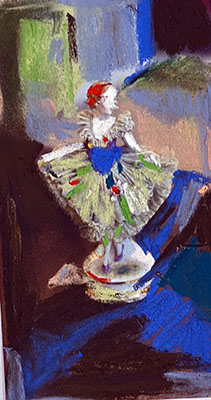
Vanda Campbell is a painter and sculptor who has exhibited widely and runs courses and workshops from her studio in Saffron Walden. She provided members with a very thought-provoking and entertaining Colour Workshop. Colour theory is a body of principles that provide guidance on the relationship between colours and the physiological impacts of certain colour combinations. Vanda explained the three rules of colour and demonstrated how great artists - contemporary and historic - consistently applied these rules to their work
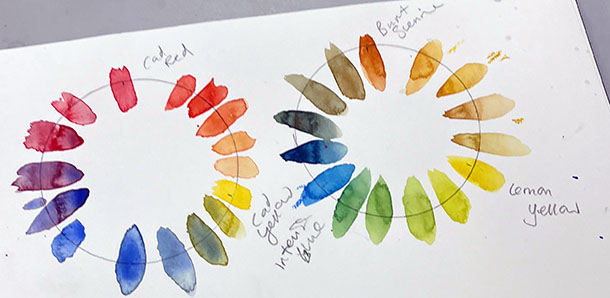

The Colour Wheel (first developed by Sir Isaac Newton in the 17th century but understood much earlier by artists such as Leonardo da Vinci) is key with the three primary colours (red, yellow and blue) used to mix three secondary colours (green, orange and purple). Further tertiary shades can be mixed in between.
The three rules:
- Analogous colour schemes use 3 adjacent colours on the colour wheel
- Complimentary colours - select 2 colours which are opposite each other
- Triadic - select 3 colours equidistant on the wheel

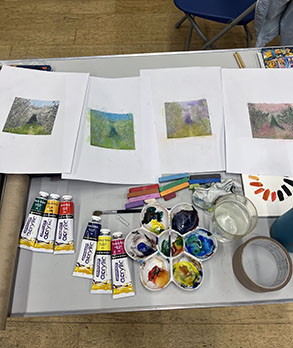
Members were then asked to explore colour combinations in their own pallets and to apply the rules and their colour choices to three copies of the same image. A discussion of the end results followed, with some stunning examples produced.
Winners of Critique Sessions 2025-2026 season

March 2025 Critique Winner, Derek Carey. The Observer, Pastle.
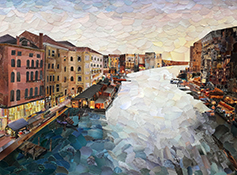
March 2025 Critique Runner Up, Kathy Burman. The Grand Canal, Venice - Collage.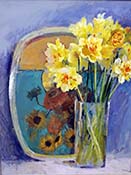
April 2025 Critique Winner, David Stowe. Daffodils, Oils.
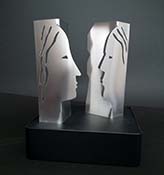
April 2025 Critique Runner Up, Kathy Burman. Face to face - Aluminium.
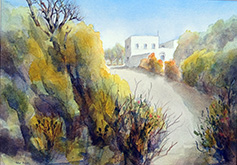
September 2025 Critique Winner, Peter Buck.

September 2025 Critique Runner Up, Alona Kushnirenko, In Truth.
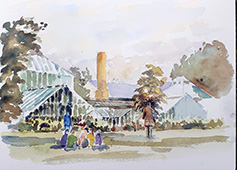
November 2025 Critique, Ray Ward. Glasshouses.
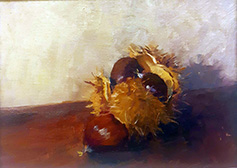
November 2025 Critique, Michael Radley. Triplets.
Winners of Critique Sessions 2024-2025 season
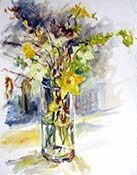
April 2024 Critique Winner, Ray Ward. Spring Flowers.
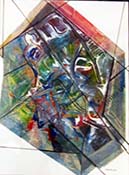
April 2024 Critique Runner Up, Mitiko Murata. Abstract.
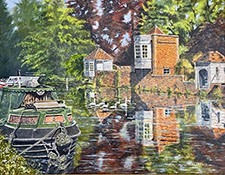
September 2024 Critique Winner, Mike Lawrence. Idyllic Serenity, Oil.
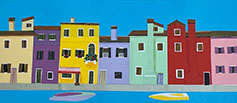
September 2024 Critique Runner up, Jenny Stratfold. Burano, Collage.
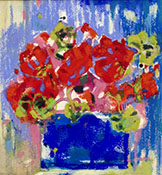
October 2024 Selected for Members' Show publicity. Jill Rolfe. Long Hot Summer.
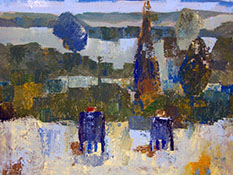
October 2024 Selected for Members' Show publicity. Geoff Bennett. Painting at Waterford Heath.

January 2025 Critique Winner, Peter Buck. Christmas, Collage.
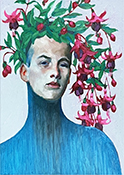
January 2025 Runner up, Anastasia Olarou. Fuchsia, Oil.
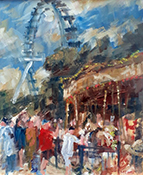
February 2025 Critique Winner, Ray Ward. Circles Of Pleasure, Acrylic.
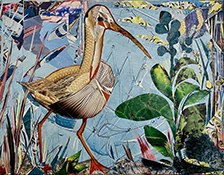
February 2025 Critique Runner up, Diane Warburton. Poppy In Ruths Garden, Collage.